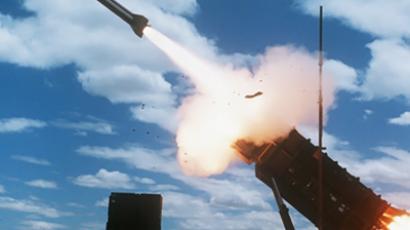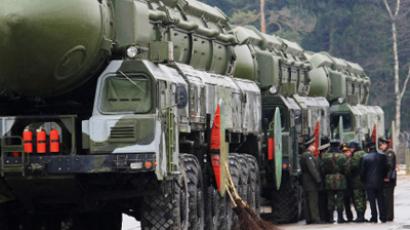Ready, steady, START!

The Russian Upper House of Parliament, the Federation Council, has ratified the START treaty on reducing Russian and American nuclear arms. It is now a step closer to coming into force.
Now approved by both houses of the Russian Parliament, the treaty must be signed by President Dmitry Medvedev.The lower chamber of the Russian Parliament, the State Duma, gave its approval on Tuesday.Before giving the approval, the State Duma deputies made several amendments or 'special statements' to the document. One of them ensures that Moscow can step out of the treaty if it feels that the US missile defense plan in Europe poses a threat to Russia’s national security. The Lower House has also legally linked offensive strategic arms and missile defense, which was one of the stumbling blocks in the long-running negotiations between Moscow and Washington.The US Senate backed the treaty earlier in December 2010 following heated public debate. The congressmen also amended the treaty prior to ratification. Washington secured its right to modernize its remaining nuclear arsenal. Another statement outlines that the treaty should not obstruct US defense plan in Europe.The amendments drawn by the both sides are non-binding, meaning that both the countries will have to keep to their obligations.After the ratification in the State Duma, the treaty will be approved by the Upper House of the Parliament and then signed by the President.
Tom Collina from the Arms Control Association in Washington remarks that despite the two countries drawing up two different resolutions to the treaty, the treaty still looks very solid. “The US Senate has ratified the text to which it made no changes and Russia will do the same. They approved resolutions that have slightly different interpretation of the treaty, but it’s ok. Countries and nations have different interpretations of the same acts and events,” he said.Collina expects the US Missile defense plan in Europe not to be a problem for this treaty, but a real issue for the next treaty in ten years from now, when the nations will be ready to drop their arms levels even lower.Political analyst Mikhail Troitsky underlines the importance of the treaty for relations between Russia and the US. “Both Presidents wanted this treaty to be a step on the way to building mutual trust. So these were not arms negotiations for their own sake, and that is very important as long as they were driven by this spirit,” he said.
Though everyone has an interest in Moscow and Washington’s bringing down the warheads, Paul Ingram, Executive Director of the British American Security Information Council, does not expect much impact on the other countries when disarmament is concerned.‘There is still huge majority of nuclear weapons residing within the United States and Russia. The next countries down have just a couple of hundred – three hundred warheads, the most being in France. So they are still a long way away from that number. The next round of negotiations (when they start it, which I do not think is any time soon) will still, in all likelihood, remain bilateral,’ Ingram said.
The differences on missile defense are to remain, believes Kingston Reif, Director at the Center for Arms Control and Non-Proliferation. He recalls that ‘the US and Russia kept the issue of missile defense on a separate track from the issue of reductions in strategic nuclear forces’. Russia’s amendments, according to Reif, are not going to influence US position on missile defense.‘The provisions on missile defense that the Duma inserted are much tamer than some critics here in the US are making them out to be. I mean they simply reiterating the positions on missile defense they stated in the unilateral statement they issued along with the new START treaty. And there really isn’t anything that the Russians have said that is going to change the US interpretation on missile defense’, Reif says.
Foreign affairs committee chairman Mikhail Margelov believes that this ratification is a significant step in relations between Moscow and Washington, however it is not enough.“We have to have more ties, we have to have more docking mechanisms, we have to have more bridges, the more interdependent we are, the better it is for our future,” he said.
The New START treaty should be viewed as "the unwinding of the excesses of the Cold War," believes Max Bergmann, a Nuclear Non-Proliferation Policy Analyst for the Center for American Progress think tank. The treaty in no way means that Russia and the US are sacrificing their own security, as after the reduction both the countries will still have “enough for both sides to deter the other and destroy the world many times over,” Bergmann says. Bergmann underlines that the military past between the two countries should no longer obscure the new reality in the relations between Moscow and Washington. “There is no need for countries that are at peace with each other to maintain such large nuclear arsenals,” Bergmann concludes.
Joel Rubin, Deputy Director and Chief Operating Officer of the National Security Network, does not find that the new treaty will create any ‘security deficit’ in either the US or Russia. Further, Rubin hopes for new dynamics in worldwide disarmament. “Now that everyone who cares about arms control and is looking into nuclear weapons as a serious issue sees that if the US and Russia can make progress it offers a new opportunity for new thinking about how they address this in 2011”, he says.
Long path to nuke-free world
Formally the New START is the fourth installment in a series of nuclear weapons reduction agreements between the two nations possessing the world’s largest arsenals. But it is only the second to actually work. START I was signed in 1991 in the wake of the collapse of the Soviet Union. The second START was signed two years later, but was never ratified, since before it could happen Russia withdrew in a protest against America’s decision to dump the ABM Treaty and build a national antiballistic shield. The third START was on the negotiation table in the late 1990s, but the talks eventually stalled.The fresh push for nuclear arms reduction was one of the key initiatives of Barack Obama after he became US President in 2009. The intention to have a replacement for START I was made public after his meeting with Dmitry Medvedev in London in April 2009. It took almost a year (enough for the previous agreement to expire) of tough negotiations before the text of the new treaty was agreed upon by Moscow and Washington.The treaty sets limits on the number of deployed nuclear warheads and their delivery systems, including ballistic missiles, strategic bombers and submarines. The target numbers are to be reached by 2017. The expiry date is 2020, and the agreement may be prolonged on both parties’ consent.There is also a new mechanism for inspections of nuclear sites set in the agreement. It is less strict than the one used under START I – and will cost less for both countries.More about New START ratification at RT.com politics section













